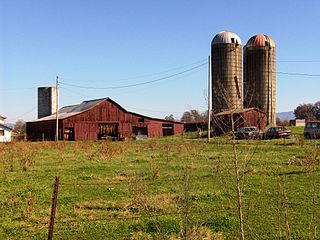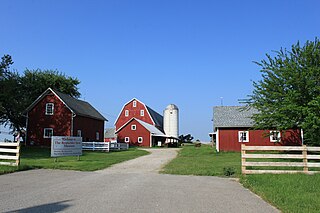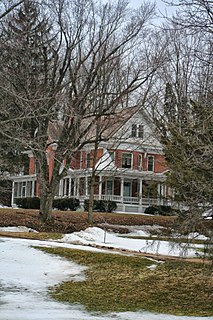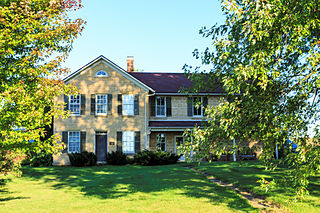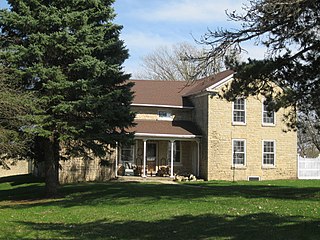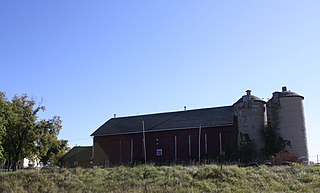Bedrud–Olson Farmstead | |
 Barn on the farmstead. | |
| Location | 996 E. Church Rd., Christiana, Dane County, Wisconsin |
|---|---|
| Coordinates | 42°57′12″N89°05′14″W / 42.95333°N 89.08722°W Coordinates: 42°57′12″N89°05′14″W / 42.95333°N 89.08722°W |
| Area | 3 acres (1.2 ha) |
| Built | 1856 |
| Architectural style | Italianate |
| NRHP reference # | 99000429 [1] |
| Added to NRHP | April 1, 1999 |
The Bedrud–Olson Farmstead is a highly intact tobacco and dairy farm with surviving buildings built between 1856 and 1915 in Christiana, Dane County, Wisconsin. [2] [3] It was added to the State and the National Register of Historic Places in 1999. [4]

Christiana is a town in Dane County, Wisconsin, United States. The population was 1,313 at the 2000 census. The unincorporated community of Utica is located within the town. It is named after Oslo, Norway and has one of the highest percentages of Norwegian ancestry in the United States.

The National Register of Historic Places (NRHP) is the United States federal government's official list of districts, sites, buildings, structures, and objects deemed worthy of preservation for their historical significance. A property listed in the National Register, or located within a National Register Historic District, may qualify for tax incentives derived from the total value of expenses incurred preserving the property.
In 1844, Tosten Lieberson Bedrud and Christie Gunderson Vossolt settled this farmstead after immigrating from Norway. They settled at the center of a small Norwegian farming community west of Lake Koshkonong. Tosten and Christie first built a dugout house near the site of the current house. At first they grew food to feed themselves. [2]

Norway, officially the Kingdom of Norway, is a Nordic country in Northwestern Europe whose territory comprises the western and northernmost portion of the Scandinavian Peninsula; the remote island of Jan Mayen and the archipelago of Svalbard are also part of the Kingdom of Norway. The Antarctic Peter I Island and the sub-Antarctic Bouvet Island are dependent territories and thus not considered part of the kingdom. Norway also lays claim to a section of Antarctica known as Queen Maud Land.

Lake Koshkonong is a reservoir in southern Wisconsin. It lies along the Rock River, 5.5 mi (8.9 km) downriver from Fort Atkinson, primarily in southwestern Jefferson County. Small portions of the lake extend into southeastern Dane and northern Rock counties.
By 1856 they had added wheat-farming to their business and seven children to the family. In that year they replaced the sod house with a wooden house, which survives as the east ell of the current house. Tosten died in 1857. His son Hellick Tostenson bought the farm in 1874 and by 1877 it totaled 198 acres. (Note that these immigrants were so fresh that they named Hellick following the old Scandinavian system where his surname was his father's name followed by 'son,' rather than a family name.) [2]

In architecture, an ell is a wing of a building that lies perpendicular to the length of the main portion.
Starting around the time of the Civil War, the farm began shifting from wheat to dairy, expanding the herd of cows. In 1883 Hellick built the current barn, with a limestone basement wall and cedar board and batten walls above. The barn had modern features for the time: two interior wood-stave silos, built in the year that the UW College of Agriculture first recommended silos for winter feeding. The barn also had calving pens, a gravity-driven water system, a manure disposal system, and ventilators. Those features remain largely unchanged, and were used into the 1960s. [2] [5] Also in 1883, the north-south ell of the house was added to make space for another family hired to help work the farm. [2] [6]

The American Civil War was a war fought in the United States from 1861 to 1865, between the North and the South. The Civil War is the most studied and written about episode in U.S. history. Primarily as a result of the long-standing controversy over the enslavement of black people, war broke out in April 1861 when secessionist forces attacked Fort Sumter in South Carolina shortly after Abraham Lincoln had been inaugurated as the President of the United States. The loyalists of the Union in the North proclaimed support for the Constitution. They faced secessionists of the Confederate States in the South, who advocated for states' rights to uphold slavery.

Limestone is a carbonate sedimentary rock that is often composed of the skeletal fragments of marine organisms such as coral, foraminifera, and molluscs. Its major materials are the minerals calcite and aragonite, which are different crystal forms of calcium carbonate (CaCO3). A closely related rock is dolostone, which contains a high percentage of the mineral dolomite, CaMg(CO3)2. In fact, in old USGS publications, dolostone was referred to as magnesian limestone, a term now reserved for magnesium-deficient dolostones or magnesium-rich limestones.

A silo is a structure for storing bulk materials. Silos are used in agriculture to store grain or fermented feed known as silage. Silos are more commonly used for bulk storage of grain, coal, cement, carbon black, woodchips, food products and sawdust. Three types of silos are in widespread use today: tower silos, bunker silos, and bag silos.
In 1889 Hellick's sister Anna and her husband Anton Olson, another Norwegian immigrant, bought the farm. By this time tobacco production was becoming a significant part of the business, with about 15 acres in cultivation - the broad-leafed variety used for cigar wrappers that is commonly grown around Dane County. In 1890 they built what is now the northernmost tobacco-curing shed near the field north of the buildings. Every third board on the side is hinged, which let the farmer control the amount of air reaching the curing leaves hanging inside. [7] Two other old curing sheds were moved nearby in 1906 and 1908. A stripping shed was built nearby in 1910, [8] where the workers stripped the cured leaves from the stalks and packed them into crates to be sold. [2]

Tobacco is a product prepared from the leaves of the tobacco plant by curing them. The plant is part of the genus Nicotiana and of the Solanaceae (nightshade) family. While more than 70 species of tobacco are known, the chief commercial crop is N. tabacum. The more potent variant N. rustica is also used around the world.
Henry and Martin Olson, sons of Anton and Anna, bought the farm in 1918, and farmed there into the 1970s. The old brothers changed the farm very little over the years. Other combination dairy/tobacco farms remain in the area, but this one is different in that it retains a full set of buildings from the late 1800s/early 1900s without newer buildings added. [2]

